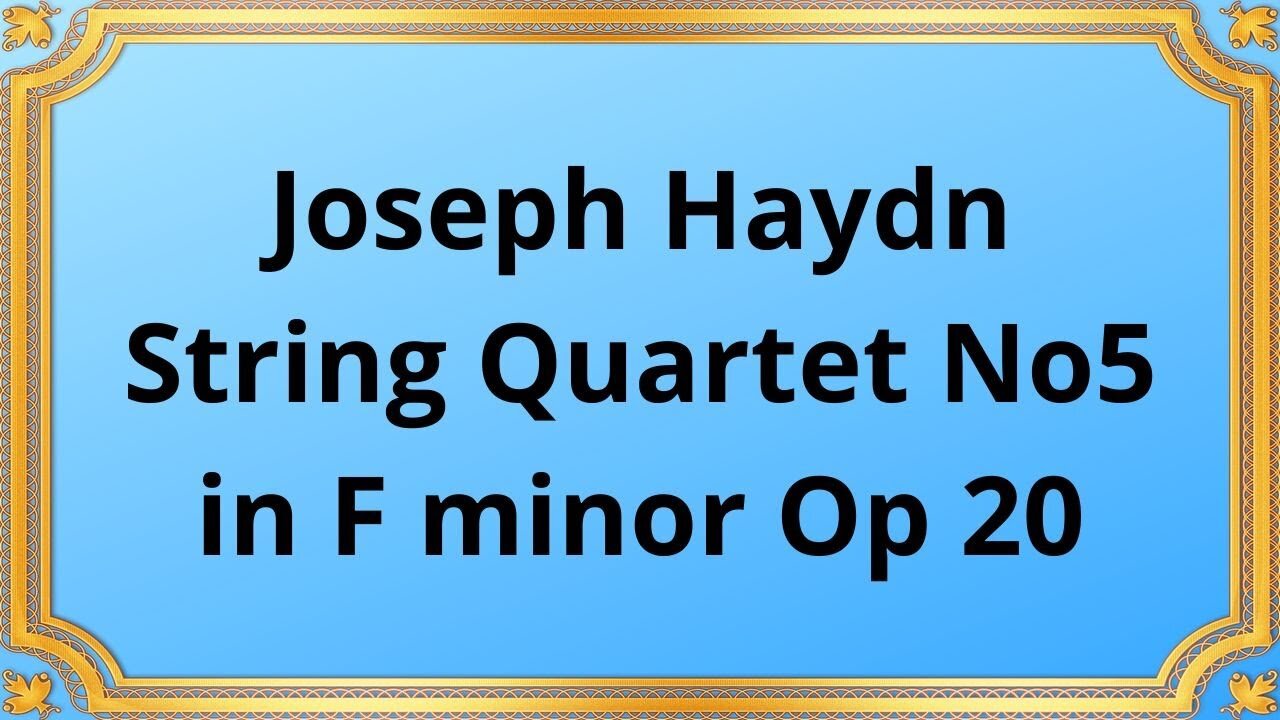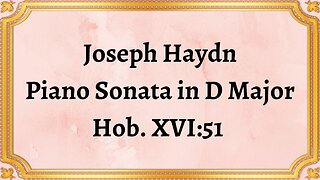Premium Only Content

Joseph Haydn String Quartet No5 in F minor Op 20
#JosephHaydn #StringQuartet #Fminor #Op20 #classicalmusic #musicalcomposition #SunQuartets #historicalcontext #musicalcharacteristics #emotionaldepth #innovativeform #influentialcomposer
JOSEPH HAYDN COMPLETE STRING QUARTETS OF OP20
"The Sun Quartets"
Publication date 1952
SCHNEIDER QUARTET
Alexander Schneider, First Violin
Isidore Cohen, Second Violin
Karen Tuttle, viola
Madeline Foley, violoncello
Within the realm of classical music, certain compositions stand as timeless masterpieces, and the "Joseph Haydn String Quartet No. 5 in F minor, Op. 20" is undoubtedly one of them.
Composed in 1772, Joseph Haydn's String Quartet No. 5 in F minor, Op. 20 is part of a collection of six quartets known as the "Sun Quartets." These quartets were dedicated to Haydn's patron, Prince Nikolaus Esterházy, and they marked a turning point in Haydn's career. With this collection, Haydn expanded the possibilities of the string quartet genre, pushing the boundaries of form and expression.
Haydn's String Quartet No. 5 in F minor is a captivating four-movement composition that showcases the composer's mastery of the string quartet medium. The opening movement, marked Allegro moderato, sets the stage with its brooding and dramatic atmosphere. The quartet engages in a musical dialogue, weaving intricate melodies and harmonies that evoke a sense of melancholy and introspection.
The second movement, marked Menuetto, presents a contrasting mood with its graceful and elegant dance-like character. Haydn's use of syncopation and dynamic contrasts adds depth and complexity to this movement, creating a sense of tension and release. The quartet navigates through moments of unity and moments of gentle interplay, captivating the listener with its artful precision.
The third movement, marked Adagio, takes the quartet to a deeply emotional realm. This movement is characterized by its lyrical and introspective nature, as Haydn showcases his ability to write heartfelt melodies that resonate with the listener's emotions. The quartet's rich harmonies and expressive phrasing create a sense of profound beauty and vulnerability.
The final movement, marked Allegro molto, brings the quartet to a powerful and energetic conclusion. It is a display of technical virtuosity, featuring rapid passages and intricate rhythmic patterns. Haydn's skillful manipulation of form and structure keeps the listener engaged, as the quartet navigates through moments of intensity and moments of respite, building towards a dramatic and triumphant finale.
"Joseph Haydn String Quartet No. 5 in F minor, Op. 20" is renowned for its emotional depth and ability to evoke a range of feelings within the listener. From the somber and introspective moments to the moments of liveliness and triumph, Haydn captures the essence of the human experience through his musical language. The quartet's ability to convey such depth of emotion has made it a cherished work, resonating with audiences throughout the years.
Conclusion:
In conclusion, "Joseph Haydn String Quartet No. 5 in F minor, Op. 20" stands as a testament to Haydn's genius as a composer. Its historical significance, musical characteristics, and emotional depth make it a treasured masterpiece in the world of classical music. This quartet continues to captivate audiences with its rich harmonies, expressive melodies, and profound emotional journey. Haydn's ability to evoke such depth of feeling is a testament to his enduring legacy as one of the greatest composers in history.
You have the opportunity to support the channel:
https://destream.net/live/RadSiarAl/donate
https://www.buymeacoffee.com/6355radsiaral
-
 6:07
6:07
Classical music_Music Inspiration
29 days agoJoseph Haydn Piano Sonata in D Major, Hob. XVI:51
781 -
 23:34
23:34
marcushouse
8 hours ago $9.74 earnedBREAKING: Starship Launch IMMINENT – But What’s This SURPRISE Flight 9 Plan?! 🚀🔥
56.8K8 -
 8:43
8:43
Film Threat
1 day agoTHE MONKEY | Film Threat Reviews
64.5K2 -
 15:55
15:55
TSPLY
1 day agoThe Media Is Very Afraid Of FBI Director Kash Patel
47.2K40 -
 6:57
6:57
Cooking with Gruel
22 hours agoMake Cheese Great Again
37.5K12 -
 5:17
5:17
Mrgunsngear
1 day ago $7.62 earnedPresident Trump Has Appointed A New ATF Director
42.8K37 -
 48:17
48:17
Athlete & Artist Show
8 days ago $3.18 earnedS5E1: Chucky Announces First Kid, 4 Nations Face Off, and more!
54.2K3 -
 38:30
38:30
hickok45
10 hours agoSunday Shoot-a-Round # 269
72.1K18 -
 1:39:55
1:39:55
Squaring The Circle, A Randall Carlson Podcast
1 day ago#040 Humanity's Expansion Into The Cosmos: A New Age - Squaring The Circle
41.8K6 -
 12:54
12:54
ariellescarcella
19 hours agoYou're NOT Queer, Just Annoying And Boring
29.3K21